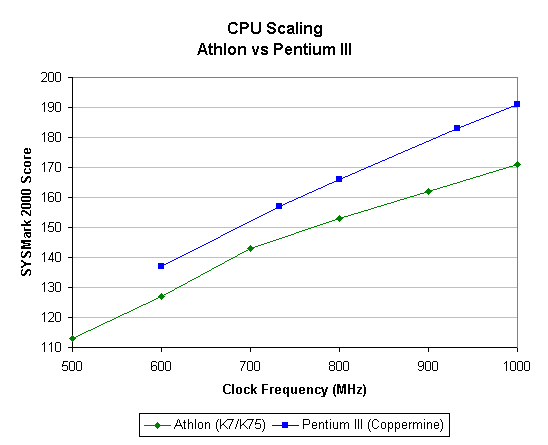AMD Athlon "Thunderbird" 1 GHz / 800 MHz
by Anand Lal Shimpi on June 4, 2000 10:10 PM EST- Posted in
- CPUs
The past few Athlon processor releases have been a tad disappointing, not because their performance wasn't up to par with the rest of the Athlon line, since they were, but mostly because, with every increase in clock speed, there seemed to be a drop in the L2 cache frequency of the processor.
The Athlon 700 was the last Athlon to feature a 1/2 L2 cache divider, which placed the processor's 512KB of L2 cache running at a whopping 350MHz, the highest L2 cache speed the Athlon would ever see.
The Athlon 750 – 850 featured a 2/5 L2 cache divider that resulted in L2 cache speeds ranging from 300MHz to 340MHz and more recently, the 900 – 1GHz parts were ashamed to boast a 1/3 L2 cache divider that kept the L2 cache frequency between 300MHz and 333MHz.
Basically, while the Athlon has increased in clock speed from the 500, 550, and 600MHz parts it debuted with back in August of 1999 to the 900, 950 and 1GHz parts that were launched in March 2000, the processor's L2 cache frequency has never peaked above 350MHz.
As the clock speed battle between the Pentium III Coppermine and the Athlon waged on, there became an increasingly larger performance difference between the two CPUs with the balance of favor tilting in the direction of the Pentium III. Why? As the clock speed of the Pentium III increased, its on-die 256KB of L2 cache increased in frequency as well, at a 1 to 1 ratio whereas the Athlon's L2 cache never exceeded the 350MHz mark.

The above graph says it all: after the Athlon 700, there was a noticeable drop in the scaling of the processor's performance with clock speed. After the Athlon 700, the speed of the processor's L2 cache never dropped below 300MHz, but then again it never reached the 350MHz point it attained with the 700MHz part, which explains the clear difference in slope before and after the 700MHz point.
If that graph were to continue on, and AMD continued to release Athlon parts with higher L2 cache dividers, we would eventually see the performance leveling off while the Pentium III Coppermine would continue to scale linearly.
Luckily for AMD, the graph isn't going to continue on like that, since AMD is finally ready to introduce the long awaited successor to the Athlon, what we've known to be the Thunderbird, along with its full speed on-die L2 cache.










0 Comments
View All Comments